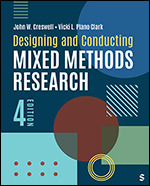Designing and Conducting Mixed Methods Research
- John W. Creswell - Department of Family Medicine, University of Michigan
- Vicki L. Plano Clark - University of Cincinnati, OH, USA
Combining the latest thinking about mixed methods research designs with practical, step-by-step guidance, the Fourth Edition of Designing and Conducting Mixed Methods Research now covers seven mixed methods designs in depth, with accompanying journal articles in the back of the book illustrating the three core mixed methods designs. Authors John W. Creswell and Vicki L. Plano Clark walk readers through the entire research process, from formulating research questions to sampling and collecting data, analyzing and integrating data, and drawing metainferences from the integrated results. This edition provides enhanced discussion of integration, joint displays, and metainferences and includes updated examples from published mixed methods studies drawn from the social, behavioral, health, and education disciplines.
The level of depth provided in this book is the exact level that we need for our introductory course to mixed methods research. The ways methods are conveyed have direct impact on how students can conceptualize the content and directly impacts their understanding and confidence in being able to apply what they learn.
The students find this text readable, useful, and refer to it as they develop their research proposal for this course. Students who conduct mixed methods research for their dissertation have found this text to be a useful guide.
